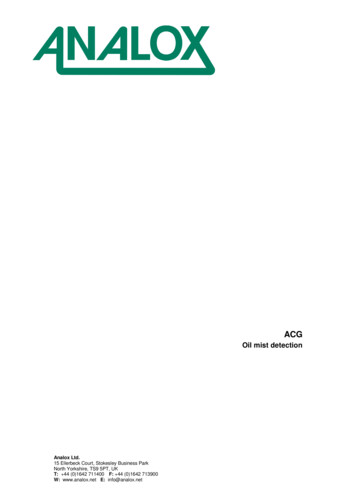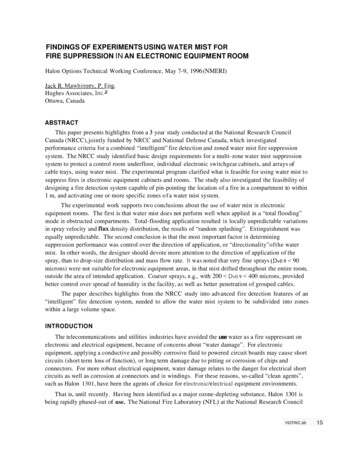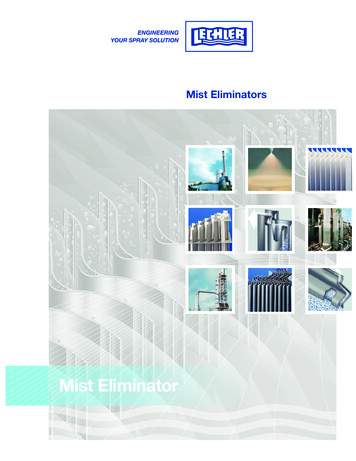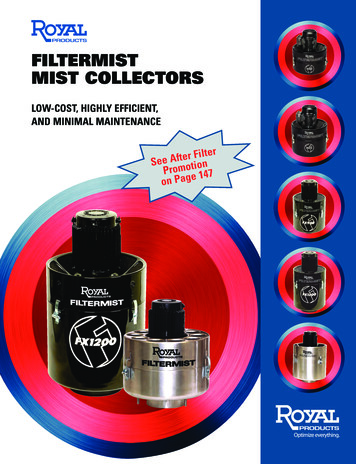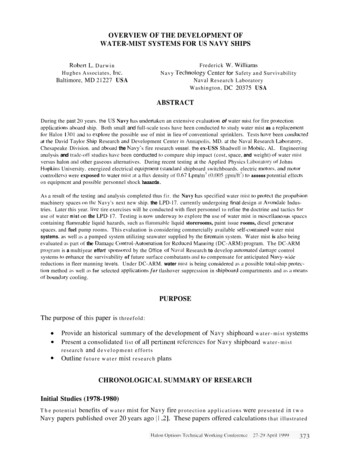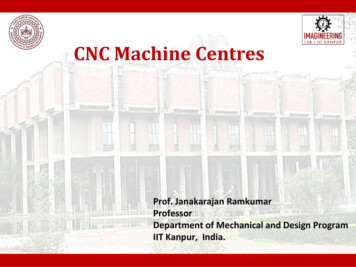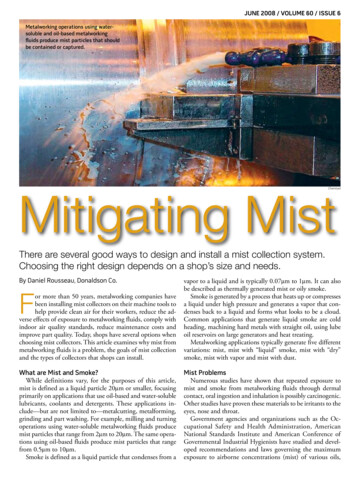
Transcription
JUNE 2008 / VOLUME 60 / ISSUE 6Metalworking operations using watersoluble and oil-based metalworkingfluids produce mist particles that shouldbe contained or captured.Mitigating MistChemtoolThere are several good ways to design and install a mist collection system.Choosing the right design depends on a shop’s size and needs.or more than 50 years, metalworking companies havebeen installing mist collectors on their machine tools tohelp provide clean air for their workers, reduce the adverse effects of exposure to metalworking fluids, comply withindoor air quality standards, reduce maintenance costs andimprove part quality. Today, shops have several options whenchoosing mist collectors. This article examines why mist frommetalworking fluids is a problem, the goals of mist collectionand the types of collectors that shops can install.vapor to a liquid and is typically 0.07µm to 1µm. It can alsobe described as thermally generated mist or oily smoke.Smoke is generated by a process that heats up or compressesa liquid under high pressure and generates a vapor that condenses back to a liquid and forms what looks to be a cloud.Common applications that generate liquid smoke are coldheading, machining hard metals with straight oil, using lubeoil reservoirs on large generators and heat treating.Metalworking applications typically generate five differentvariations: mist, mist with “liquid” smoke, mist with “dry”smoke, mist with vapor and mist with dust.What are Mist and Smoke?While definitions vary, for the purposes of this article,mist is defined as a liquid particle 20µm or smaller, focusingprimarily on applications that use oil-based and water-solublelubricants, coolants and detergents. These applications include—but are not limited to—metalcutting, metalforming,grinding and part washing. For example, milling and turningoperations using water-soluble metalworking fluids producemist particles that range from 2µm to 20µm. The same operations using oil-based fluids produce mist particles that rangefrom 0.5µm to 10µm.Smoke is defined as a liquid particle that condenses from aMist ProblemsNumerous studies have shown that repeated exposure tomist and smoke from metalworking fluids through dermalcontact, oral ingestion and inhalation is possibly carcinogenic.Other studies have proven these materials to be irritants to theeyes, nose and throat.Government agencies and organizations such as the Occupational Safety and Health Administration, AmericanNational Standards Institute and American Conference ofGovernmental Industrial Hygienists have studied and developed recommendations and laws governing the maximumexposure to airborne concentrations (mist) of various oils,By Daniel Rousseau, Donaldson Co.F
greases and lubricants.OSHA standards are enforceable by law. The OSHA standard for airborne concentration of metalworking fluids isless than 5.0 mg/m3 of air over an 8-hour period. Since thelate 1990s, organizations have petitioned OSHA to lowerits 8-hour exposure standard for metalworking fluids to 1.0mg/m3, 0.5 mg/m3 and 0.2 mg/m3. Some companies haveimplemented their own more stringent requirements—downto 0.1 mg/m3 of air over an 8-hour period.Goals of Mist CollectionThe objectives of mist collection are to prevent mist frombecoming airborne, prevent workers from breathing mistladen air and to eliminate or prevent haze. Mist collection experts agree that these goals can be best achieved by containingthe mist within a metal or plexiglass machine tool enclosureand only capturing the lightest and smallest mist particlesgenerated inside that enclosure that otherwise would drift outof the machine tool enclosure.If this is done well, the finest and lightest mist particlesthat cause indoor air pollution are filtered out of the air bythe mist collector. When mist collection is not done well, thefollowing may occur:1. Mist escapes through the machine tool access doors, chipconveyors and other openings in the machine tool.2. Too much mist is pulled into the mist collector, limitingproper cooling and lubrication.3. The mist collector is collecting so much mist that itcannot filter it fast enough, requiring frequent filterchanges.To avoid these problems, shops installing mist collectorsmust determine needed airflow for the application. Thereare several methods for determining airflow needs, which arediscussed in detail in a technical reference guide published byDonaldson Co. (see Editor’s Note on page 95 for informationon obtaining a copy of the guide).Other important considerations include sizing the unitbased on airflow and combining mist sources from differentfluids, which are discussed in the guide.Types of CollectorsOnce a shop has determined airflow needs and otherconsiderations, it can choose among several mist collectionalternatives.n Machine-mounted mist collector.n Single mist collector ducted to one machine (singleducted).n Single mist collector for a machining center cell—typically three to four machining centers (cellular system).n Central mist collector for up to 20 machining centers(central system).n Ambient mist filtration.Machine-mounted systems. This collector is the mostpopular and in many cases the most practical solution
(Figure 1). The top-mounted collector may be open on the bottomand directly connected to themachining center or connected by a short piece offlex hose or ducting.On collectors with a bottom inlet, the drain is typicallynot designed for continuous operations.n Low ceilings, overhead cranes and electrical conduits mayinterfere with operation.n Multiple machines require multiple collectors.n High energy usage.Advantagesn Flexibility to move themachining center easilywhen manufacturing operations change.n Ability to power upthe collector only whenthe machining centerDonaldsonis on. (Donaldson Co. Figure 1: Mist collector mounts on toprecommends using a of a machining center.machine tool interlockwith each machine for maximum energy savings and longestfilter life.)n Oil/coolant is returned to the machining center.n No floor space required.n Simple maintenance routines.n Only one machine is without mist collection during anysignificant mist collector maintenance.Disadvantagesn Each machine requires a motor starter.Ducted single machining center systems. A single mistcollector for a single machine where the mist collector ismounted on the floor, hung from the ceiling or mounted to abeam is the second most common mist collector installation(Figure 2). It is typically used:n when machine-mounting is not an option due to the sizeor weight of the mist collector,n where top access to the machining center is required,andn where tolerances are so critical that motor vibration fromthe collector may affect part quality.These systems are typically mounted no more than 10'from the machining center and have minimal ducting.nAdvantagesn Flexibility to easily move machining center when operations change.n The collector is turned on only when machining centeris on. (Donaldson Co. recommends a machine tool interlockwith each machine.)
n Simple maintenance.n Only one machine is without mist collection during mistcollector maintenance.Disadvantagesn Each machine requires a motor starter.n Ducting must be installed properly to minimize leaks.n Multiple machines require multiple collectors.n High energy usage.Ducted cellular systems. These systems use a single mistcollector for a machining cell with two to four machiningcenters (Figure 3). Parts manufactured in a machining cellmay move between machines or the same part may be manufactured in each machine. The machines typically use thesame oil or coolant. In these instances, installing one mistcollector for the machining cell may be more practical thanusing individual mist collectors.Advantagesn Mist collector only operates when machining cell is operating. (Machine tool interlocks are recommended.)n Energy usage is minimized by using fewer collectors andfewer fans to operate.n Maintenance needs to be performed on only one mistcollector, not multiple units, reducing maintenance time andfilter and disposal costs.n Collected mist can be easily returned to the coolantfiltration system of one machine or the centralcoolant filtration system.n When the machining cell is modified orno longer necessary, the mist collector can bemoved elsewhere.Disadvantagesn Ducting must be installed properly to minimize chance of leaks.n Balancing the airflowbetween all machines soeach machine has enoughairflow requires expertise.DonaldsonDucted central mistFigure2:Mistcollectoriscollection systems. Thesesystems use a single mist connected by ducting to a singlecollector ducted to up to machining center.20 machine tools. These large systems were popular in thepast, but are no longer common due to the disadvantagesnoted below.Advantagesn Lowest-cost mist collector solution (one collector formany machines).n Single fan and single motor starter quickens installation.n Maintenance staff has to schedule filter changes on only
one unit.Disadvantagesn Unit’s fan is either on or off. This wastes energy for facilities that don’t run all machines at once.n Requires large amount of floor space.n Installation cost may be higher due to more ducting andlarger duct diameters.n Ducting must be selected and installed properly to minimize chance of leaks.n Duct diameter for main run is larger and can requireextra floor space.n Larger duct runs may require additional static pressure towork well, minimizing a central system’s energy benefit.n If shop is using more than one metalworking fluid, thecollected mist cannot be reused, resulting in higher disposalcosts.n When the mist collector is down or maintenance isrequired, all or a large portion of the plant’s mist collectionsystem will be down.n Balancing airflow between all machines is difficult.Figure 3: A single mist collector supports several machiningcenters.Ambient mist filtration. This system is designed to remove mist from general plant air without being connectedto the mist source. Ambient systems are infrequently used asa primary mist filtration system, but are used in cases wheresource capture cannot be done effectively or done at all. Ambient mist filtration is occasionally used as a secondary systemDisadvantagesn Ambient systems have a maximum system efficiency of70 percent (average efficiency during normal operations is 50percent), which may not be efficient enough to meet local,state, federal or union requirements.n Ambient systems require that specific airflow patternsDonaldsonto provide exceptional air quality.Advantagesn Can be used when there are several machines that haveno enclosures or when 100 percent mist containment andcapture cannot be achieved.n Used after source capture units are installed on all machines to provide a high degree of air cleanliness.
be managed for the entire plant—from ambient mist filtration systems, HVAC, personal fans and any other air movingdevice. If the airflow patterns don’t work together or if thefacility opens doors and windows to bring in fresh air, systemefficiencies typically fall to less than 50 percent.n To be captured by a system, mist must rise into the plant’sairflow pattern. This means workers are still exposed to a highconcentration of mist at the generation source.n Airflow patterns from ambient units can stain buildingwalls when mist is entrained in the discharge air.There are five steps that can maximize the effectiveness ofan ambient mist collection system installation.1. What is the volume of the room that to be filtered?Measure the room’s height, width and length to calculate thevolume of air to be filtered and use this equation:Total air volume of room length width height2. Is the volume of mist in the air light, medium or heavy?If the mist is light, allow 20 minutes per air exchange; if it ismedium, 15 minutes; if it is heavy, 10 minutes.3. Calculate the airflow required for the ambient system,dividing the volume of air to be filtered by the minutes perair change:Total air volume of roomTotal cfm Minutes per air changeFor example, consider a shop area 200' 100' 20' with me-TOOL & CUTTER GRINDERSNEEDED IN SEATTLE!A VERY STABLECOMPANY INSEATTLE NEEDSEXPERIENCED CNCAND MANUALTOOL AND CUTTERGRINDERS. GREATPAY AND BENEFITS.PAID RELOCATION.SWIFT-CARB 1-800-227-9876SERVING THE METALWORKING COMMUNITY SINCE 1960!SEND YOUR RESUME TO: AARON@SWIFTCARB.COMdium-volume mist. The following equation calculates theamount of airflow required:Total cfm 200' 100' 20'. 26,667 cfm15 minutes per air change4. Determine the type of mist collector to be used and thenominal airflow for that unit. Manufacturers of ambient airfiltration systems can provide this information. To determinehow many mist collectors will be required, divide the totalairflow from the previous equation by the nominal airflow ofthe selected mist collectors as shown:No. of mist collectors Total cfmcfm per mist collectorFor example, it is common for a media/V-bag-style mistcollector to operate at 3,000 cfm per collector. The number ofcollectors needed is determined by the following equation:No. of mist collectors 26,667 cfm3,000 cfm 8.9 mist collectorsBecause you can’t install and operate part of a mist collector, nine mist collectors, each operating at 3,000 cfm, arerequired to properly filter the mist in this example.5. Lay out how the collectors will fit into the room so thatthe airflow pattern captures the mist. For maximum captureefficiency, position the mist collectors to develop an oval airflow pattern by pushing air from the exhaust of one unit to
the inlet of another. To create the oval airflow pattern:n the distance from one unit’s exhaust to the inlet of thenext should be no less than 50' and no more than 100',n the side-to-side distance between units should be nogreater than 50',n never place the exhaust of a mist collector closer than 20'from any corner, andn the typical distance between the side of a unit to the wallis 10' to 20'.In one example, calculations called for nine 3,000-cfmmist collectors, but when it came to locating the mist collectors, 10 were required to complete the airflow pattern. Inthis example, a figure eight airflow pattern was developed. Ifthe manufacturer of the ambient systems offers 6,000-cfmmist collectors, two of these collectors could substitute forthe four 3,000-cfm mist collectors in the middle of the figureeight. Lastly, the units that blow air directly towards the wallsshould use louvers to turn the exhaust so air is “bounced” offthe walls towards the inlet of the next collector.With the right information, a shop can purchase the rightmist collector for its operation, knowing that the design willwork well and provide years of useful service. Suppliers ofmist collection systems can provide the guidelines a shopneeds to choose the right system and work with the shop toCTEbuild an optimal solution.Editor’s Note: This article is adapted from “Mist Collection ofMetalworking Fluids,” a technical reference guide published byDonaldson Co. The full text includes sections on how shops candetermine their mist collection needs, types of collector installations, how to install mist collectors, and selecting the right mistfilter media and collector configurations. It is available fromDonaldson by request. Send requests by e-mail to donaldsontorit@donaldson.com.About the Author: Daniel Rousseau istechnical product manager, Donaldson ToritMist Collection, Donaldson Co., Minneapolis.He has more than 13 years of experience inthe air filtration industry with specific interestin metalworking fluid mist filtration. Contacthim by e-mail at dan.rousseau@donaldson.com. Donaldson is a global provider of filtrationsystems and replacement parts. For more information about thecompany’s mist filtration products, call (800) 365-1331 or visitwww.donaldsontorit.com.CUTTING TOOL ENGINEERING Magazine is protected under U.S. and international copyright laws.Before reproducing anything from this Web site, call the Copyright Clearance Center Inc. at (978) 750-8400.
choosing mist collectors. This article examines why mist from metalworking fluids is a problem, the goals of mist collection and the types of collectors that shops can install. What are Mist and Smoke? While definitions vary, for the purposes of this article, mist is defined as a liquid particle 20µm or smaller, focusing


